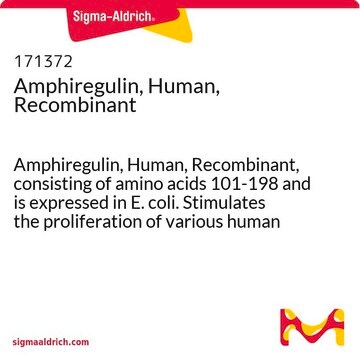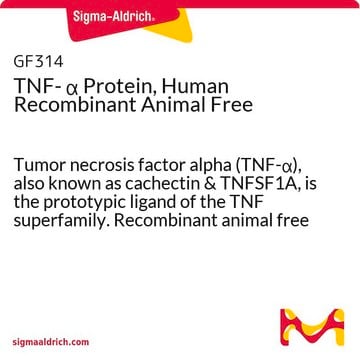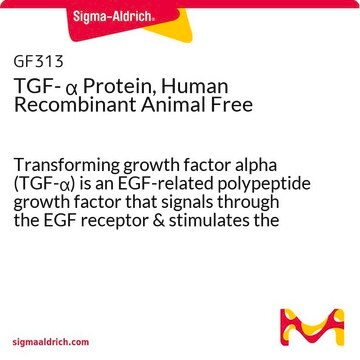SRP3033
Epiregulin human
recombinant, expressed in E. coli, ≥98% (SDS-PAGE), ≥98% (HPLC), suitable for cell culture
Synonym(s):
EREG
Sign Into View Organizational & Contract Pricing
All Photos(1)
About This Item
UNSPSC Code:
12352202
NACRES:
NA.75
Recommended Products
biological source
human
recombinant
expressed in E. coli
assay
≥98% (HPLC)
≥98% (SDS-PAGE)
form
lyophilized
potency
<0.2 ng/mL
mol wt
5.6 kDa
packaging
pkg of 25 μg
technique(s)
cell culture | mammalian: suitable
impurities
<0.1 EU/μg endotoxin, tested
color
white to off-white
UniProt accession no.
shipped in
wet ice
storage temp.
−20°C
Gene Information
human ... EREG(2069)
General description
EREG (epiregulin) is mainly known as a ligand of EGFR (epidermal growth factor receptor) and ErbB-4 (receptor tyrosine-protein kinase). It induces tyrosine phosphorylation of EGFR, ErbB-2, ErbB-3 and ErbB-4. The mechanism of action involves interaction with EGFR, dimerization of EGFR and induction of autophosphorylation. The EREG gene is mapped to human chromosome 4q13.
Recombinant human Epiregulin is a 5.6kDa monomeric protein, containing 50 amino residues, which corresponds to the mature secreted Epiregulin sequence.
Recombinant human Epiregulin is a 5.6kDa monomeric protein, containing 50 amino residues, which corresponds to the mature secreted Epiregulin sequence.
application
Epiregulin human has been added in the culture medium to study the effect of epiregulin on epithelial invasion.
Epiregulin human has been used as a supplement in media 199 to stimulate human epidermal keratinocytes. It has also been used to treat colon cancer cells to test its effect on cell migration.
Biochem/physiol Actions
EREG (epiregulin)-mediated EGFR (epidermal growth factor receptor) phosphorylation is responsible for the activation of various pathways, including the mitogen-activated protein kinase (MAPK), phosphoinositide 3-kinase (PI3K) and STAT5 (signal transducer and activator of transcription 5) responses. These pathways are involved in proliferation, cell survival, and angiogenesis. EREG is upregulated in colon, breast and ovarian cancers.
Sequence
MVAQVSITKC SSDMNGYCLH GQCIYLVDMS QNYCRCEVGY TGVRCEHFFL
Physical form
Lyophilized with no additives.
Reconstitution
Centrifuge the vial prior to opening. Reconstitute in water to a concentration of 0.1-1.0 mg/ml. Do not vortex. This solution can be stored at 2-8°C for up to 1 week. For extended storage, it is recommended to further dilute in a buffer containing a carrier protein (example 0.1% BSA) and store in working aliquots at -20°C to -80°C.
Storage Class
11 - Combustible Solids
wgk_germany
WGK 3
flash_point_f
Not applicable
flash_point_c
Not applicable
Certificates of Analysis (COA)
Search for Certificates of Analysis (COA) by entering the products Lot/Batch Number. Lot and Batch Numbers can be found on a product’s label following the words ‘Lot’ or ‘Batch’.
Already Own This Product?
Find documentation for the products that you have recently purchased in the Document Library.
Chanat Kumtornrut et al.
Journal of dermatological science, 93(3), 150-158 (2019-02-23)
The main pathogenesis of acne vulgaris is increase in sebum production and abnormal keratinization of the hair infundibulum. The androgens are involved in acne pathogenesis by modulating sebaceous glands to enhance sebum production. However, the molecular mechanisms of abnormal keratinization
Serum levels of hepatocyte growth factor and epiregulin are associated with the prognosis on anti-EGFR antibody treatment in KRAS wild-type metastatic colorectal cancer.
Takahashi N, et al.
British Journal of Cancer, 110, 2716-2716 (2014)
The human obesity gene map: the 2005 update.
Rankinen T, et al.
Obesity (Silver Spring, Md.), 14, 529-529 (2006)
Hyo Jin Gim et al.
European journal of medicinal chemistry, 85, 107-118 (2014-08-01)
A series of azaisoflavone analogs were designed and synthesized and their transactivation activities and binding affinities for ERα and ERβ were investigated. Among these compounds, 2b and 3a were the most potent with 6.5 and 1.1 μM of EC50, respectively. Molecular
Y Shirakata et al.
The Journal of biological chemistry, 275(8), 5748-5753 (2000-02-22)
Epiregulin is a new member of the epidermal growth factor (EGF) family purified from conditioned medium of NIH-3T3 clone T7. Some EGF family growth factors play essential roles in human keratinocytes in an autocrine manner. We show here that epiregulin
Our team of scientists has experience in all areas of research including Life Science, Material Science, Chemical Synthesis, Chromatography, Analytical and many others.
Contact Technical Service






